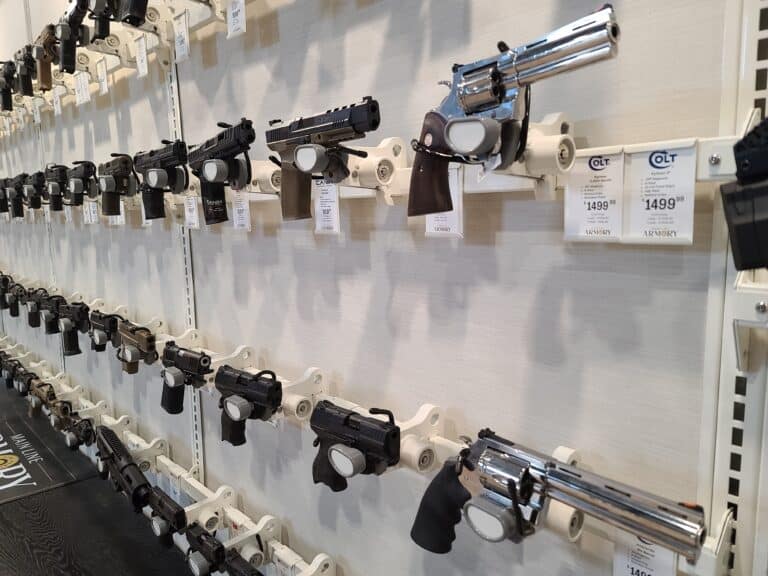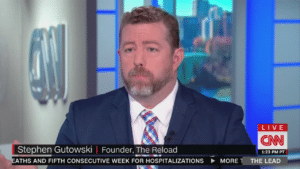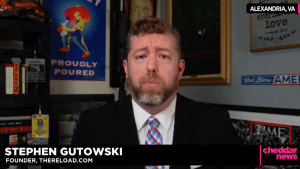The University of Southern California (USC) released a new guide for filmmakers that hopes to stigmatize some kinds of gun use in entertainment.
“Trigger Warning: Gun Guidelines for Media,” published last week, provides guidance on how TV shows, movies, and even news shows should approach issues such as officer-involved shootings, gun storage, mass shootings, school shootings, and partner violence. USC said it aimed to change the impact that media have on how Americans view guns. However, despite claims the guide is about promoting “responsible gun ownership,” the school’s guide repeated a number of disputed studies and claims commonly used by gun-control groups.
“From ‘designated driver’ to ‘buckle up,’ we all know how Hollywood helped make our roads safer by depicting responsible driving. Could there be a better moment than this one for the entertainment industry to get behind a similar effort for gun safety, and depict responsible gun ownership?” Kate Folb, director of USC’s Hollywood, Health & Society, which published the guide, said in a press release. “TV shows are in a unique position to change the narrative, reset the bar, and provide representation of safe, responsible behavior when it comes to firearms.”
The guide represents a new front in the campaign by gun-control advocates to influence Hollywood’s portrayal of firearms. It follows a years-long effort that saw activists from groups like Brady United and Everytown for Gun Safety directly consult on scripts for major tv shows and movies. In 2016, Brady even helped make a feature film called Miss Sloane.
“Miss Sloane marks another chapter in Brady’s partnership with Hollywood to integrate the realities of gun violence into entertainment,” Brendan Kelly, then a press secretary for Brady, told the Washington Free Beacon at the time. “We’ve consulted on scripts for powerhouse television shows including The Good Wife and Grey’s Anatomy.”
Brady, which USC called “the nation’s oldest and boldest gun violence prevention group” in its press release on the guide, is hoping it will have a greater impact than Miss Sloane. That movie bombed at the box office, fetching one of the worst opening weekends up to that point.
“Hollywood leaders want to use their talents and voices to inspire positive culture change,” Kris Brown, president of Brady, said in a press release. “Outraged by the tragedy in Uvalde, this time last year about 300 leading writers, directors, and producers signed Brady’s open letter committing to modeling gun safety on screen. Now, they have a roadmap to turn that commitment into tangible change.”
On the other hand, Gun Owners of America attacked the USC guide as “trash.”
“They downplay or outright ignore the benefits that firearms provide—such as, how guns are used to save lives far more often than to take life,” Erich Pratt, the group’s senior vice president, told The Reload. “And the ‘guidelines’ discuss law enforcement without mentioning the fact the overwhelming majority of police support gun rights: 91% of police support concealed carry for civilians, and 86% believe that armed civilians can help avoid and/or reduce mass shootings.”
The guide is heavily influenced by Brady and Everytown, with 20 of the 52 resource links it provides going directly to the gun-control groups’ websites. It does not feature any links to gun-rights organizations.
USC’s guide includes a section on the”myth” of “the good guy with a gun” and that “guns make us safer.” That section, and several others, outline talking points often touted by Brady and Everytown but heavily disputed by gun-rights advocates.
“This myth is used to justify lenient concealed-carry legislation that allows people to carry loaded guns in public,” the guide reads. “However, a recent study found American states that allow concealed carry have higher rates of gun homicide than those that do not.”
The guide does not mention that all states allow concealed carry. It also doesn’t provide any statistics on defense gun usage, estimated by a CDC-funded study as being between 60,000 to 2.5 million per year. Instead of presenting any countervailing viewpoints on gun ownership and use, the guide declares that “easy access to guns” is a deterrent to America.
It encourages filmmakers to consider the impact of portraying the use of guns in a positive light.
“According to research by the USC Norman Lear Center Media Impact Project (MIP), gun storylines are most effective on viewers who do not own guns. Even though gun owners are tougher on the whole to persuade, gun storylines do still have an effect on their opinion,” the guide says. “In other words, your stories matter.”
However, it also cautions them not to push messages about gun use too far or portray gun owners negatively. USC argues that could backfire.
“Appeal to common values,” the guide says. “Heavy-handed stories can be alienating to gun owners who feel their freedoms are being threatened, or their beliefs mocked. Instead of making gun owners the antagonist, appeal to the common values shared by parents and others who care about keeping children safe.”
The guide is also highly critical of depictions of domestic violence survivors who own or use firearms for self-defense.
“Media and storylines that advocate for women to be armed with guns is particularly dangerous since the empirical truth is this: access to a firearm is directly associated with an increased risk of intimate partner homicide,” the guide says. “The only real way to reduce intimate partner homicide is to disrupt access to firearms for both victim and abuser.”
Depictions of safe storage were another priority outlined in the guide. However, the guide advocates for a stringent kind of gun storage that mandates a gun always be stored unloaded, and separate from ammunition. It encourages filmmakers never to show a character face negative consequences from storing their guns in line with what the guide suggests, but instead show characters who don’t store guns in that way experiencing bad outcomes.
“In the MIP study looking at depictions of gun safety on TV, a storyline about a child shooting a playmate with an improperly stored gun led viewers to feel less safe with a firearm at home, and made them more likely to endorse the importance of storing guns and ammunition separately,” the guide said.
The USC guide also criticizes the depiction of police officers in many TV shows and movies. It says that police lawbreaking is often “presented as routine, harmless, necessary, or even noble.” The guide argues Hollywood portrays “any actions by law enforcement, up to and including shooting civilians” as “inherently justifiable.” Depictions of race, where police are often minorities and bad guys are often white, were flagged as problematic in the guide as well.
“Whereas law enforcement officers with guns are depicted as diverse ‘good guys,’ those who are shot on TV are typically nameless ‘bad guys,’ who are — perhaps surprisingly — predominantly white,” the guide said. “This inaccurate representation of gun casualties masks and distorts the ways in which shootings by law enforcement disproportionately affect communities of color. In reality, this violence is far from colorblind: Black Americans are three times more likely to be killed at the hands of law enforcement.”
The guide includes less controversial sections detailing how entertainment or news media can adjust how they represent some events to help reduce their likelihood in the future, such as suicide. It pointed to over 100 studies that back up the idea suicide can be contagious, and the way media cover the issue can exacerbate it. It offered suggestions for how to talk about suicide in ways that don’t encourage it and provide resources to viewers who may be struggling with suicidal ideation.
Ultimately, the USC guide concludes that Hollywood creatives have immense influence over audiences and they should use it to “change the narrative, reset the bar, and provide representation of safe, acceptable behavior when it comes to firearms.”
“Your voice and talents are needed now more than ever,” the guide says. “Your stories matter.”
UPDATE 6:01 PM Eastern 5-30-2023: This piece has been updated with comment from Gun Owners of America.







2 Responses
“Media and storylines that advocate for women to be armed with guns is particularly dangerous since the empirical truth is this: access to a firearm is directly associated with an increased risk of intimate partner homicide,” the guide says. “The only real way to reduce intimate partner homicide is to disrupt access to firearms for both victim and abuser.”
Interesting quote here. A couple is in an abusive relationship – the victim has access to a gun and kills the abuser in self defense – and this counts as “intimate partner homicide.”
The paper is actually saying that defending oneself, if it means killing the abuser, is something that needs “reduced.”
So much for valuing women’s rights and safety….
Yea, I thought that passage was pretty odd as well. They seem to be arguing that victims of abuse shouldn’t have guns because their abusers might take the gun and use it against them. Or, as you suggest, the implication could be even more bizarre.